Coach Jeremy
Latest posts by Coach Jeremy (see all)
- Try These Shooting Drills with The Extreme Passing Kit - April 24, 2014
- Stickhandling Drills with the Dangler - March 5, 2014
- 5 Shooting Drills With the Extreme Passer Pro - January 26, 2014
Why Length Matters when Buying a Hockey Stick
When you buy a hockey stick, one of the most important factors is the length of the hockey stick. Experienced hockey players know the exact length they like. The length of a hockey stick is mainly chosen by personal preference, however the length does affect the performance of the stick and the hockey player. It will be difficult for a hockey player to control the puck and shoot the puck if the stick is too short or too long for them. Also it seems that players who share a certain playing style or position tend to prefer a similar hockey stick length, we will discuss this later. First, let’s look at how to measure the length of a hockey stick and how to choose the right length.
How to Measure the Length of a Hockey Stick
In order to properly measure the length of a hockey stick a player should be wearing hockey skates. Hockey skates add a few inches in height, so a stick that comes up to the players nose without skates, may only reach their chin while on skates. If you are buying a hockey stick, and you don’t have skates with you, make sure you remember to add an inch or two in length to suit your needs while on the ice.
To measure the length, have the player stand straight up, looking forwards. Have the shaft of the stick parallel to the players body, with the toe of the blade of the stick on the ground (see picture below)
Average length of a hockey stick – If you are playing hockey for the first time a good starting point for the length of your stick is between the chin, and nose.
What classifies a long stick, and a short hockey stick? – Typically any stick that is above the nose will be classified as long, and any stick that is below the chin would be a short stick.
What Length Should Your Hockey Stick Be?
Like we mentioned earlier, the length of the hockey stick is usually chosen by personal preference, but it takes time to develop a playing style and a preference for stick length, so here is our short guide to picking the right length.
Short Hockey Stick “The Dangler” – Hockey players who are good at stickhandling tend to prefer shorter sticks. Using a short stick makes it a bit easier to move the puck around because the stick will be lighter (less material) and a shorter stick is easier to move around the body.
Many players who are good at stickhandling tend to bring the puck in close to their body in order to protect the puck while pulling a deke. A short stick makes it easier to perform these moves.
Average Hockey Stick “The Grinder” – Grinders like to get in the corners, dig for pucks, and cause trouble in front of the net. With an average length stick you can still easily handle the puck, and also make poke checks, intercept passes, and hammer off a slapshot.
Long Hockey Stick “The Defensemen” – It is common for defensemen to have the longest sticks on the team. A long hockey stick gives you a longer reach, which makes it easier for you to poke the puck away from attackers, intercept passes, and stop a puck before it leaves your end.
Defensemen are also known to have hard slapshots, and a longer stick (with the right technique) will provide more power on the slapshots.
Disclaimer: While the above points are common in hockey, that does not mean they are absolute truths. Some defensemen use short sticks, while some hockey players who are great with the puck use a longer stick. These tips should help beginner players find a length to start at, but don’t be afraid to try something new!
Adjusting Stick Length
When buying a hockey stick it may be hard to find the perfect length in the store. It is normal to buy a stick that is too long, and then cut it down to suit your length preference. For younger players it is also common to put a wooden plug in the end of a stick to make it longer (if they out grow the stick).
Picking the Right Flex
Remember that cutting the stick does affect the flex of the shaft. If you want to learn more about finding the perfect flex for your hockey stick then check out our hockey stick flex guide (coming soon).
Hockey Stick Buying Resources
- For more information about hockey sticks be sure to visit our Hockey Stick Buying Guide
- For information on the flex of a stick read our Hockey Stick flex Guide
- For information on choosing a curve read our curve guide
- For discounts on hockey sticks visit the Clearance Section on Hockey Monkey


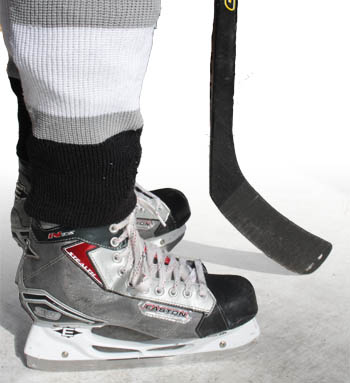
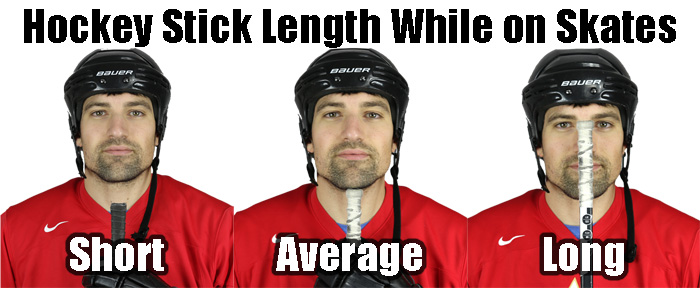

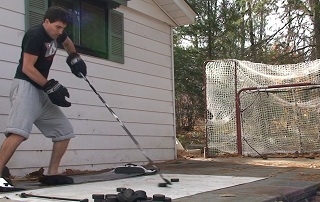
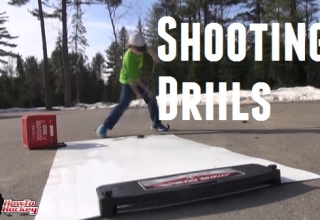
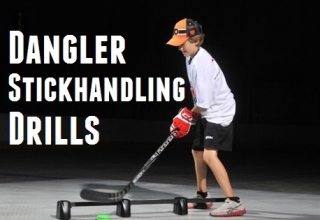
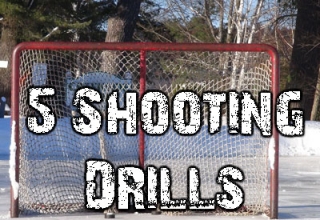





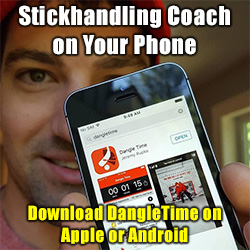










VANDYZ27
January 12, 2011 at 2:13 am
have you ever looked at crosby or any of the top pros. their sticks are about shoulder height !!!! Don’t you think maybe they would know.
ANONYMOUS
January 16, 2011 at 3:12 pm
I think if you look closer you will see they all have personal preferences. Not every pro player has a shoulder length stick. The most common stick length will range from about an inch below the chin to eyebrows.
SUSANST11
March 15, 2011 at 3:19 pm
What about if you play ball hockey….do we still use the same measurements as in ice hockey? I was
told that a shorter stick in ball hockey is better, but being a defenceman I like a longer stick for poke checking etc.
Tuse
JEREMY
March 18, 2011 at 2:29 pm
It all comes down to personal preference in the end. In ball hockey you aren’t wearing skates so your stick will be a bit shorter. If you like a longer stick for poke checks then use a longer stick!
BOB@HOTMAIL.COM
April 6, 2014 at 3:07 am
I think for ball hockey the same thing applies because as you run you should be in an “athletic stance” You should have your stick between your collar bone and chin. I have seen some defense men use sticks at nose height for bigger rinks.
MATT_27
October 20, 2011 at 8:15 pm
Pro forwards use sticks that go up to the top of their chest. Chin height and up is way too long. So your photo of a short stick is quite misleading.
REGGIEDUNLOP
November 20, 2011 at 4:25 pm
This may be one of the most misleading guides I have read on stick length, but it is also the same common misleading knowledge that promotes bad hockey from a young age and is being spread by coaches like wildfire. While this websites’ efforts to spread hockey knowledge is commendable, I feel it necessary and as a coach, the right thing to do in further explaining my opening statement. While in one of the posts here, the HQ editor notes that stick length is preference, so then is the ability to play hockey well. A stick cut too long at a young age prohibits a player from developing an athletic posture, which in turn prohibits the ability to skate correctly. At one point in the history of hockey, defensemen were told to use long sticks for poke checking, but the real solution to getting your stick blade to that same area is developing better foot speed. This way, the defensemen’s body is also more likely the be positioned closer to the puck carriers which gives him the option of “puck or body” as coaches say. Physics also suggests a shorter stick being better for any player based on rotational force principals: it takes more force to control the stick blade at a distance further away from the point generating the force (in this case, the force is the shoulder). As stick length goes up, the force required to control the blade of the stick does as well. Whats more, the further away a players stick is from his line of vision, the more mental adjustment it takes to read where a pass to or from that stick will end up. As the pass distance grows, so does the variance angle required to read and adjust to the single point of interest to or from the stick blade. And to keep on going, for those of you spending 200+ on sticks and breaking the heal constantly, please consider a shorter stick. A long stick and a bunch of slap shots means a centralized point of force at the heal of the blade as it makes contact with the ice. Sacrifice one week of frustration with a shorter stick and the benefits in the long run will outweigh that frustration by tenfold. Good talk, see ya out there.
ROBBY
May 18, 2012 at 12:13 am
very valid point. i have been playing hockey now for 19 years and i still see to this day players with their sticks way too long. as a matter of fact, like you said, try a shorter stick and see the benefits. harder shot because you will be forced to use more of your lower body, and better puck control
CHER0028
November 22, 2011 at 3:51 pm
read it better boys.. it says average.. it doesn’t say recommended … it doesn’t say long or short is wrong.. calm down you guys have been watching too many of those hockey commentators pffft
BOB
February 7, 2012 at 11:33 pm
nice write up reggiedunlop. I agree with most of your points. But sometimes longer sticks makes all the difference in the world especially for defending. One or two inches can drastically effect your playing style.
MICHAEL BOWLER
August 7, 2012 at 3:52 pm
As someone whose coach got him to go to a shorter stick in high school I can say there are costs and benefits. Yes it is easier to stickhandle but you lose speed having the puck closer in to the body and also your back gets sore. Would that my coach would have shortened the stick just to chin on skates and then lowered the lie of the stick because I am shorter and skate closer to the ice. You don’t say anything about stick lie which may also contribute to shorter stick length of pros who are taller and use higher lies. Lot more complexity here, but the simple solution of significantly shortening the stick is not always best.
WILLIAM H
January 14, 2017 at 1:09 am
Its all comes down to personal preference but if your new to hockey you won’t have a preference then I beleive that a new players stick should be between the chin and nose with skates on. And then when a new player uses that stick a few times he/she can decide what they prefer.